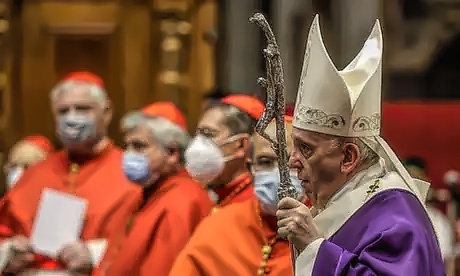Pope Francis’ decision to postpone and widen the planned 2022 synod is extraordinary and invites everyone to stop and take a deep breath.
The planned subject — “For a synodal Church: communion, participation and mission” — remains the same but the new means adopted are now more intrinsically suited to such a topic.
The Synod of Bishops has been changing in the 21st century.
Previously, under Pope John Paul II, they were stale events, with bishops reading canned speeches and amending a text that had been prepared in advance.
Pope Benedict XVI introduced the innovation of allowing anyone to speak on any topic in the final hour of each day’s general assembly, what I called “the karaoke hour.”
Pope Francis has further increased the amount of genuine dialogue at each synod and now will broaden that dialogue with a universal period of preparation at the diocesan level, followed by a continent-wide dialogue, and finally the meeting in Rome.
What is more, as Cardinal Mario Grech, secretary-general of the Synod of Bishops, made clear in announcing the new schedule, the consultation is intended to include the whole people of God.
“The governing principle of this consultation of the people of God is contained in the ancient principle ‘that which touches upon all must be approved by all,’ ” Grech said in an interview.
“This is not about democracy, or populism or anything like that. Rather, it is the church that as the people of God, a people who by virtue of baptism, is an active subject in the life and mission of the church.”
The churches of Latin America have been the most successful so far in developing a synodal process with the meetings of their continent-wide episcopal conference, CELAM.
The meetings include a great deal of prayer, beginning with prayer together for several days before turning to business items.
The documents they have produced — at Medellin, Puebla, Santo Domingo, Aparecida — have been among the most theologically fertile post-conciliar texts.
Ecclesiologist Massimo Faggioli recently wrote about synodality — albeit before the announcement from the Vatican — and about the ways it does, and does not, reflect models of sociopolitical organization in the ambient culture.
“The modern theology of synodality originates chronologically in contemporary theology of the Catholic Church, and geographically within societies in the liberal-democratic order in the Western hemisphere,” he wrote.
“This is not just a coincidence.”
We will look forward to Faggioli and other theologians explaining this lack of coincidence in greater detail!
Theologians — start your engines!
Indeed, Faggioli already has another column on this subject that examines some of the global issues in greater detail.
Certainly, in the history of the U.S. church, the provincial councils and, later, plenary councils of Baltimore reflected a synodal model in the 19th century. In the 20th century, the bishops’ conference sometimes channelled a similar approach, overcoming wide differences of opinion at the outset of a discussion and yet forging a consensus.
For example, their 1983 pastoral letter “The Challenge of Peace: God’s Promise and Our Response” was debated for more than two years, and the final vote was a nearly unanimous 238-9.
In 2004, on the contentious issue of Communion for pro-choice politicians, the bishops’ conference adopted a document, “Catholics in Political Life”, by a vote of 183-6.
In recent years, regrettably, the U.S. bishops have lost much of their ability to work together; indeed they do not seem to like each other very much, and so I worry how they will manage to engage in this new and promising synodal process. Continue reading
Additional readingNews category: Analysis and Comment.




